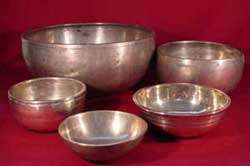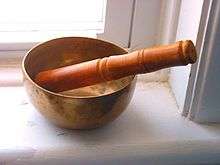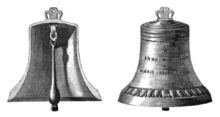Singing bowl
Singing bowls (also known as Tibetan Singing Bowls, rin gongs, Himalayan bowls or suzu gongs) are a type of bell, specifically classified as a standing bell. Rather than hanging inverted or attached to a handle, singing bowls sit with the bottom surface resting, and the rim vibrates to produce sound characterized by a fundamental frequency (first harmonic) and usually two audible harmonic overtones (second and third harmonic).
Singing bowls are used worldwide for meditation, music, relaxation, and personal well-being. Singing bowls were historically made throughout Asia, especially Nepal, China and Japan. They are closely related to decorative bells made along the Silk Road from the Near East to Western Asia. Today they are made in Nepal, India, Japan, China and Korea.
Origins, history and usage
In some Buddhist practices, singing bowls are used as a signal to begin and end periods of silent meditation. Some practitioners (for example, Chinese Buddhists) use the singing bowl to accompany the wooden fish during chanting, striking it when a particular phrase is chanted. In Japan and Vietnam, singing bowls are similarly used during chanting and may also mark the passage of time or signal a change in activity, for example changing from sitting to walking meditation. In Japan, singing bowls are used in traditional funeral rites and ancestor worship. Every Japanese temple holds a singing bowl. Singing bowls are found on altars and in meditation rooms worldwide.
There aren't any traditional texts about singing bowls so far as we know. All known references to them are strictly modern. However, a few pieces of art dating from several centuries ago depict singing bowls in detail, including Tibetan paintings and statues. Some Tibetan rinpoches and monks use singing bowls in monasteries and meditation centers today. Singing bowls from at least the 15th century are found in private collections. Bronze bells from Asia have been discovered as early as the 8th–10th century BC and singing bowls are thought to go back in the Himalayas to the 10th-12th century AD.
Singing bowls are played by striking the rim of the bowl with a padded mallet. They can also be played by the friction of rubbing a wood, plastic, or leather wrapped mallet around the rim of the bowl to emphasize the harmonic overtones and a continuous 'singing' sound.
Both antique and new bowls are widely used as an aid to meditation. They are also used in yoga, music therapy, sound healing, religious services, performance and for personal enjoyment. A randomised controlled clinical study did not find a difference in pain relief between treatments with singing bowls and a placebo treatment, while both provided significant positive effect in comparison with untreated controls.[1]
Antique singing bowls

Antique singing bowls produce harmonic overtones creating an effect that is unique to the instrument. The subtle yet complex multiple harmonic frequencies are a special quality caused by variations in the shape of the hand made singing bowls. They may display abstract decorations like lines, rings and circles engraved into the surface. Decoration may appear outside the rim, inside the bottom, around the top of the rim and sometimes on the outside bottom.
Modern development

Singing bowls are still manufactured today in the traditional way as well as with modern manufacturing techniques. New bowls may be plain or decorated. They sometimes feature religious iconography and spiritual motifs and symbols, such as the Tibetan mantra Om mani padme hum, images of Buddhas, and Ashtamangala (the eight auspicious Buddhist symbols).
New singing bowls are made in two processes. Hand hammering is the traditional method of creating singing bowls which is still used to make new bowls. The modern method is by sand casting and then machine lathing. Machine lathing can be done only with brass, so machine lathed singing bowls are made with modern techniques and modern brass alloy.
See also
References
- ↑ Wepner, Florian; Hahne, Julia; Teichmann, Angelika; Berka-Schmid, Gertraud; Hördinger, Annette; Friedrich, Martin (2008). "Quarzklangschalentherapie bei Wirbelsäulenbeschwerden und chronobiologische Vorgänge – eine randomisierte kontrollierte Studie" [Treatment with crystal singing bowls for chronic spinal pain and chronobiologic activities - a randomized controlled trial]. Forschende Komplementärmedizin (in German). 15 (3): 130–7. doi:10.1159/000136571.
Further reading
- de Leon, Emile (2012) The Mastery Book of Himalayan Singing Bowls: A Musical, Spiritual, and Healing Perspective (Book & Audio CD's) Temple Sounds Publishing / ISBN 9780988266100 / Library of Congress Control Number: 2012948143
- Müller-Ebeling, Claudia, Christian Rätsch, Surendra Bahadur Shahi (2002). Shamanism and Tantra in the Himalayas. Trans. by Annabel Lee. Rochester, Vermont: Inner Traditions.
- Shrestha, Suren (2009). How to Heal with Singing Bowls: Traditional Tibetan Healing Methods (Book and Audio CD). Sentient Publications. ISBN 978-1-59181-087-2.
- Jansen, Eva Rudy (2004). Singing Bowls. A Practical Handbook of Instruction and Use. New Age Books, New Delhi. ISBN 81-7822-103-9.
- Terwagne, Denis; Bush, John W M (2011). "Tibetan singing bowls". Nonlinearity. 24 (8): R51–66. Bibcode:2011Nonli..24R...1T. doi:10.1088/0951-7715/24/8/R01.
- Inácio, Octávio; Henrique, Luís L.; Antunes, José (2006). "The Dynamics of Tibetan Singing Bowls". Acta Acustica united with Acustica. 92 (4): 637–53.
- Young, Diana; Essl, Georg (2003). HyperPuja: a Tibetan Singing Bowl controller. NIME '03 Proceedings of the 2003 conference on New interfaces for musical expression. pp. 9–14.
External links
| Look up Singing bowl in Wiktionary, the free dictionary. |
| Wikimedia Commons has media related to Singing bowls. |
